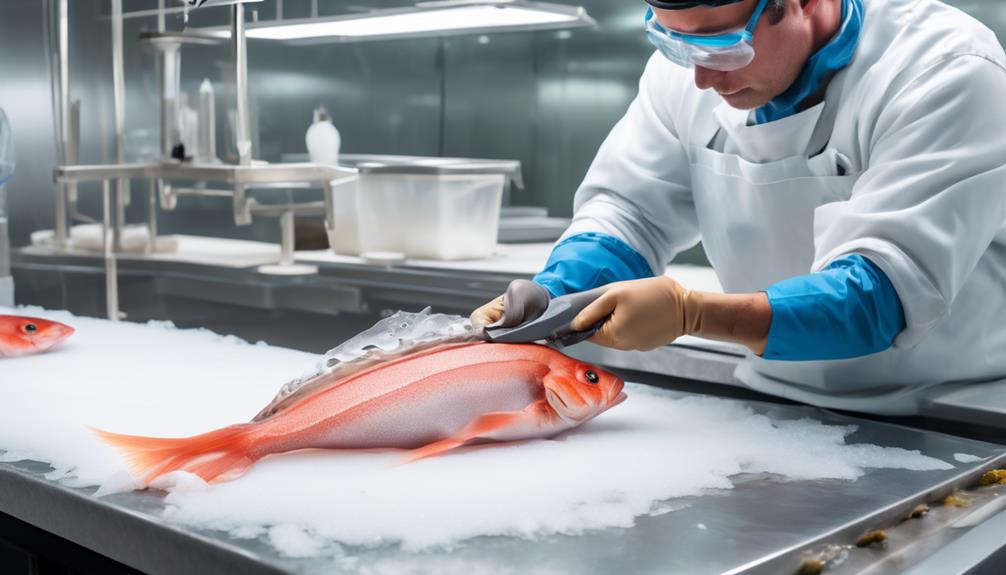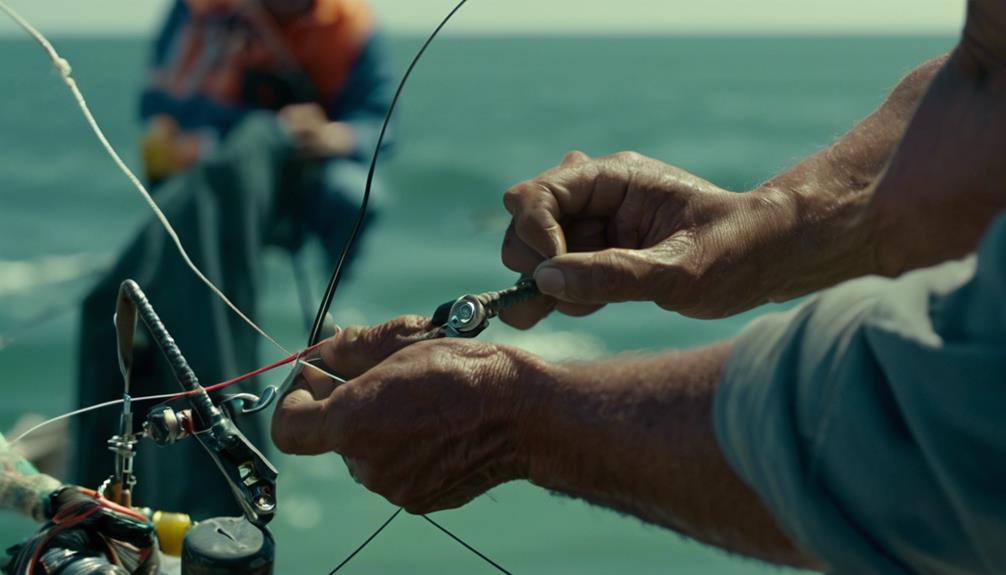Torn between the allure of calm inshore waters and the excitement of offshore big game? When it comes to mastering saltwater fishing, understanding the optimal seasons can make all the difference.
Each season offers its own unique challenges and opportunities for anglers seeking to reel in the big catch. But how do you determine which season is best for your saltwater fishing adventures? There's much to consider, from the behavior of the fish to the weather conditions and the best time of day to cast your line.
Mastering the optimal seasons for saltwater fishing is a key to unlocking the full potential of your angling pursuits.
Spring: Prime Time for Inshore Fishing
Spring is the optimal season for inshore fishing, offering ideal conditions for catching a variety of saltwater species. During this time, understanding inshore tactics and tidal patterns is crucial for a successful fishing trip. In spring, the warming weather triggers fish to move closer to the shore, making them more accessible to anglers. As the tide changes, it affects the distribution and behavior of baitfish and predatory species, impacting where and how you should fish. To maximize your catch, pay attention to the tidal patterns and plan your fishing trips around the incoming and outgoing tides.
Bait selection is another essential aspect of inshore fishing in spring. With the abundance of baitfish inshore during this season, it's important to match the hatch. Using live bait such as shrimp, mullet, or pilchards can be highly effective. Additionally, lures that mimic the movement of these baitfish can also yield great results. Varying your bait selection based on the specific species you're targeting can significantly improve your chances of success.
When it comes to fishing techniques, adapting to the conditions is key. In spring, fish are often more active, so using techniques like topwater lures or shallow diving plugs can be very productive. Working these lures along the surface or near the shallows can entice aggressive strikes from hungry fish. Additionally, casting near structures like mangroves or docks can increase your chances of hooking onto a prized catch. Be ready to adjust your techniques based on the behavior of the fish and the prevailing conditions for a rewarding inshore fishing experience in spring.
Summer: Offshore Adventures and Big Game
As the water continues to warm up, you'll find that summer brings new opportunities for offshore adventures and pursuing big game fish in saltwater. The summer season is ideal for venturing further out into the ocean for offshore trolling and deep sea excursions. This is the time when passionate anglers set their sights on the thrilling pursuit of Marlin fishing and the exciting challenges that come with tuna season.
Offshore trolling during the summer months presents the perfect opportunity to target larger species such as Mahi-Mahi, Wahoo, and King Mackerel. The warm waters attract these pelagic species, providing an exhilarating experience for those seeking a big catch.
Additionally, summer brings about the peak of Marlin fishing season. Whether you're targeting Blue Marlin, White Marlin, or Sailfish, the summer months offer the best chances for encountering these majestic creatures.
For those with a taste for adventure, deep sea excursions in the summer can lead to epic battles with powerful tuna species. Yellowfin tuna, in particular, are highly sought after during this season, offering fierce fights and unmatched thrills for anglers willing to take on the challenge.
Fall: Redfish and Speckled Trout Galore
With the arrival of fall, you'll find an abundance of redfish and speckled trout awaiting your skilled hands and adventurous spirit in saltwater fishing. As the water temperature begins to cool down, redfish and speckled trout become more active and plentiful in coastal areas, making fall an optimal time for anglers to target these prized species.
Understanding the impact of water temperature and tidal patterns is crucial for maximizing your success during this season.
During fall, the cooling water temperatures trigger redfish and speckled trout to feed more aggressively, preparing for the winter months ahead. As a result, these fish become more responsive to bait and lures, providing anglers with increased opportunities for successful catches. Pay close attention to the water temperature changes and focus your efforts on areas where the temperature remains relatively stable, as this is where redfish and speckled trout are likely to gather in larger numbers.
In addition to water temperature, tidal patterns play a significant role in the behavior and movement of redfish and speckled trout during fall. Understanding how tides influence the movement of baitfish and other prey can help you strategically position yourself to intercept these game fish. As tides change, they create currents that carry food sources, attracting redfish and speckled trout to specific areas. By studying tidal patterns and their effects on fish behavior, you can enhance your chances of a successful fishing expedition during the fall season.
Winter: Deep Sea Fishing for Trophy Catches
Prepare for an exhilarating adventure as you head out into the deep sea during winter, where you can pursue trophy catches and experience the thrill of landing impressive game fish. Winter is an excellent time for deep sea fishing, offering a unique set of opportunities to target a variety of prized species.
Winter: Bottom Fishing, Wrecks, and Reefs: During the winter months, many big game species seek shelter in the deeper waters near wrecks and reefs. Bottom fishing during this season can yield impressive results, with species such as grouper, snapper, and amberjack being commonly targeted. These areas provide a haven for these fish, making them prime locations for anglers seeking a challenge and a chance to reel in some truly impressive specimens.
Winter: Targeting Migratory Species, like Sailfish and Wahoo: Winter also brings the migration of sought-after species such as sailfish and wahoo. These fast and powerful fish make for an exciting deep sea fishing experience. By targeting these migratory species during the winter months, anglers can test their skills against some of the ocean's most prized game fish, adding an extra layer of excitement to their fishing expeditions.
As you venture into the deep sea during winter, be prepared for a rewarding and thrilling experience. Whether you're bottom fishing around wrecks and reefs or targeting migratory species like sailfish and wahoo, the winter season offers an array of opportunities to pursue trophy catches and make lasting memories on the open water.
Early Morning: The Best Time to Catch Fish
In the early morning, your chances of catching fish are significantly heightened due to the increased activity and feeding patterns of marine life at that time. To maximize your early morning fishing success, it's crucial to understand the impact of tides and moon phases. These natural factors play a pivotal role in fish behavior.
During the early morning, fish are often more active during certain tidal movements, such as the incoming tide, which brings in a fresh supply of food and triggers feeding frenzies. Similarly, certain moon phases can influence fish behavior, with many species being more active during the new and full moon phases.
Another essential aspect of early morning fishing is bait selection. During this time, fish are actively seeking out their morning meal, making your choice of bait even more critical. Live bait such as shrimp, mullet, or pilchards can be highly effective during early morning fishing excursions. The natural movement and scent of live bait can attract fish more effectively during this time when they're actively feeding.
Incorporating these factors into your early morning fishing strategy can significantly enhance your chances of a successful catch. By paying attention to tides, moon phases, and selecting the right bait, you can take advantage of the heightened feeding activity during the early morning hours and reel in some impressive catches.
Late Afternoon: Ideal for Tarpon and Snook
As you shift your focus to late afternoon fishing, the heightened feeding activity of marine life during this time creates an optimal environment for targeting tarpon and snook. The late afternoon presents unique opportunities for saltwater anglers, as these prime feeding hours often coincide with favorable tidal patterns and bait availability.
Here's what you need to know to make the most of your late afternoon fishing excursion:
- Tidal Patterns: Late afternoon fishing is often enhanced by the changing tides. As the tide begins to move, it can stimulate feeding behavior in tarpon and snook. Understanding the local tidal patterns and how they influence fish movement is crucial for maximizing your chances of a successful catch.
- Bait Selection: During late afternoons, tarpon and snook are actively seeking out prey, making it essential to choose the right bait. Live bait such as mullet, pilchards, or pinfish can be highly effective for enticing these species during this time. Additionally, lures that mimic the movement of these natural baits can also yield impressive results.
- Location Strategy: Target areas with structure and cover, such as mangroves, bridges, and deep channels, as these are favored spots for tarpon and snook during late afternoon feeding frenzies. Be attentive to any signs of baitfish activity, as tarpon and snook are likely to be close by, ready to strike.
Nighttime: Exciting Opportunities for Night Fishing

When night falls, the waters come alive with exciting opportunities for night fishing, offering a unique angling experience for those who seek the thrill of the nocturnal hunt. Moonlight fishing is a captivating technique that allows you to harness the natural light of the moon to attract fish. The shimmering reflections on the water's surface can draw in prey, creating an exhilarating challenge as you navigate the nighttime waters.
Nighttime fishing presents its own set of challenges, such as limited visibility and the need for heightened awareness of your surroundings. However, for those willing to embrace the adventure, the rewards can be plentiful. Nocturnal species like snook and tarpon are more active during the night, presenting an excellent opportunity to target these elusive fish when they're most active.
Exciting techniques, such as topwater lures and live bait, can be particularly effective during nighttime fishing. The thrill of feeling a powerful strike in the darkness adds an extra level of excitement to the experience. Moreover, the tranquility of the night and the absence of daytime distractions can create a serene and immersive fishing environment.
Changing Seasons: Adapting to Different Conditions
Navigating the changing seasons while saltwater fishing requires adapting to different conditions, offering new challenges and opportunities for anglers. Adapting techniques and tackle selection are crucial for success in varying seasonal conditions. Here are three key aspects to consider when adjusting to changing seasons:
- Adapting Techniques: As seasons shift, so do the behaviors and feeding patterns of saltwater fish. During colder months, fish tend to move to deeper waters, requiring adjustments in your fishing techniques. Slow down your retrieval speed and consider using live bait to entice sluggish fish. In contrast, as the weather warms up, fish become more active and may move closer to the shore. Utilize faster retrieval speeds and experiment with lures that mimic the movements of prey to capitalize on the increased activity.
- Tackle Selection: Matching your tackle to the prevailing conditions is vital. In colder seasons, opt for smaller and more natural-colored lures, as fish are generally less aggressive and more selective in their feeding. Conversely, in warmer seasons, larger and more vibrant lures can attract the attention of active fish. Additionally, consider adjusting your line weight to accommodate the potential size of the catch during different seasons.
- Environmental Awareness: Stay attuned to changes in the environment as seasons transition. Be mindful of shifting currents, water clarity, and the presence of baitfish, as these factors heavily influence fish behavior. By adapting your techniques, tackle selection, and environmental awareness to the changing seasons, you can maximize your success as a saltwater angler.
Frequently Asked Questions
What Are the Best Types of Bait to Use for Inshore Fishing in the Spring?
For inshore fishing in the spring, the best lures to use are soft plastics, jerkbaits, and topwater lures. These work well in shallow waters near structures like docks, grass beds, and oyster bars.
How Can I Prepare for Offshore Fishing in the Summer, Especially if I've Never Done It Before?
If you're new to summer offshore fishing, start by researching the best tackle selection for the species you want to target. Get familiar with local regulations, weather patterns, and safety measures. Consider hiring a guide for valuable beginner tips.
Are There Specific Techniques for Targeting Redfish and Speckled Trout in the Fall?
When targeting redfish and speckled trout in the fall, focus on using live bait and lures that mimic their natural prey. Look for them in shallow waters near marshes and grassy areas. Use light to medium tackle for best results.
What Are Some Common Deep Sea Fishing Mistakes to Avoid in the Winter?
When deep sea fishing in winter, avoid common mistakes like not adjusting to the colder water temperatures, ignoring weather forecasts, or using the wrong bait. Utilize proper deep sea fishing techniques to maximize your winter catch.
How Can I Stay Safe While Night Fishing in Changing Seasons With Different Conditions?
When night fishing in changing seasons, ensure safety by checking weather conditions, bringing proper equipment, and being prepared for emergencies. Stay alert, use reliable lighting, and have a communication plan in place.
Conclusion
Now that you understand the optimal seasons for saltwater fishing, get out there and test your skills. Take advantage of the spring for inshore fishing, summer for offshore adventures, fall for redfish and speckled trout, and winter for deep sea trophy catches.
Remember to adapt to changing conditions and make the most of early mornings, late afternoons, and even nighttime fishing. With these tips, you'll be well on your way to mastering saltwater fishing.
Tight lines!



